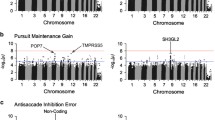Summary.
Genetic studies of autism would benefit from the identification of (neurophysiological) markers of the disease. Reports that subjects with autism suffer from abnormalities of visual motor processing, indicate that abnormalities in smooth pursuit eye movements (SPEM) may be a marker of the disorder. Sixteen high-functioning school-aged children with pervasive developmental disorder (PDD) were compared with a matched group of eighteen normally developing controls on performance of a SPEM task and a task which tested the integrity of visually guided saccadic eye movements. Both groups of children had normal eye movements during performance of these tasks. Thus abnormalities in SPEM would appear not to be a marker of PDD. The earlier reported abnormalities in visual motion processing might need to be reinterpreted.
Similar content being viewed by others
Explore related subjects
Discover the latest articles, news and stories from top researchers in related subjects.Author information
Authors and Affiliations
Rights and permissions
About this article
Cite this article
Kemner, C., van der Geest, J., Verbaten, M. et al. In search of neurophysiological markers of pervasive developmental disorders: smooth pursuit eye movements?. J Neural Transm 111, 1617–1626 (2004). https://doi.org/10.1007/s00702-004-0164-5
Received:
Accepted:
Published:
Issue Date:
DOI: https://doi.org/10.1007/s00702-004-0164-5




